 |
 |
 |
| |
COMPARISON OF THE EFFECTS OF LOPINAVIR/RITONAVIR AND EFAVIRENZ ON GENE EXPRESSION AND DIFFERENTIATION OF HUMAN ADIPOCYTES
|
| |
| |
Reported by Jules Levin
10th Intl Workshop on Adverse Drug Reactions and Lipodystrophy in HIV, London Nov 6-8 2008
J Diaz-Delfin1, JM Gallego-Escuredo1, M Milanski1, JCDomingo1, MM Gutierrez 2, MG Mateo 2, P Domingo 2, M Giralt1, F Villarroya1
1Department of Biochemistry and Molecular Biology and Institut de Biomedicina, University of Barcelona, and 2 Department of Internal Medicine, Hospital de la Santa Creu i Sant Pau, Barcelona, Spain.
INTRODUCTION
Lopinavir/ritonavir (4:1) and efavirenz are drugs of choice for initial antiretroviral therapy in HIV-1-infected patients. Several separate reports indicate deleterious effects of these drugs on adipocytes in vitro, specially using rodent cell models of adipocyte differentiation. Moreover, recent data suggest a potential action of efavirenz treatment on abnormal fat deposition in patients and liponavir/ritonavir treatment has been associated with metabolic alterations in HIV-1-infected, HAART-treated, patients
AUTHOR CONCLUSIONS
Exposure of adipocytes to the lopinavir/ritonavir combination used in HAART impairs adipogenesis and increases inflammation-related gene expression, but to a lesser extent than equivalent amounts of efavirenz. Mitochondrial toxicity is not involved in these effects. Preferential induction of ER stress by lopinavir/ritonavir (4:1) does not appear to be associated with worsening the effects of this drugs combination on adipocyte biology respect to efavirenz. From Jules: so are these methods good science and are the findings reliable???
AIM
Our objective was to perform a parallel assessment of the effects of the lopinavir/ritonavir (4:1) combination commonly used in anti-retroviral treatment respect to the action of efavirenz on human adipocytes in culture, and to compare their actions on differentiation and on the expression of marker genes of adipogenesis, inflammation, mitochondrial toxicity and endothelial reticulum stress, as well as on the release of regulatory adipokines by cultured adipocytes.
METHODS
Human adipocytes were differentiated in primary culture from precursor cells obtained from liposuction material from healthy individuals. We determined the effects of exposure to equivalent concentrations of lopinavir/ritonavir (4:1) and efavirenz of pre-adipocytes during their 10-day differentiation process into adipocytes. The same comparison was performed by studying the effects of 24h exposure to lopinavir/ritonavir (4:1) and efavirenz to already differentiated human adipocytes. Morphology of adipocyte differentiation (number of cells accumulating lipid droplets), lactate release to the medium (Roche Accutrend) as well as changes in mRNA expression for marker genes (TaqMan real-time PCR, Applied Biosystems) were determined. Quantification of the abundance of specific proteins released by adipocytes to the culture medium was performed using the Multiplex technology (Millipore).
Effects of efavirenz and lopinavir/ritonavir on human adipocyte differentiation
Human pre-adipocytes were differentiated in culture in the presence of the indicated concentrations of drugs (10 days since confluence). A, micrographs of cell cultures. B, a quantitative assessment of the extent of differentiation respect to controls (set up arbitrarily as 100%). Quantification was performed through image analysis of percent of surface occupancy by adipocytes using 4 random micrographs for each individual culture condition. Expression of data is shown as means + SEM and p values for Student't t test comparison are shown when statistically significant (P < 0.05). If not significant. NS is marked.
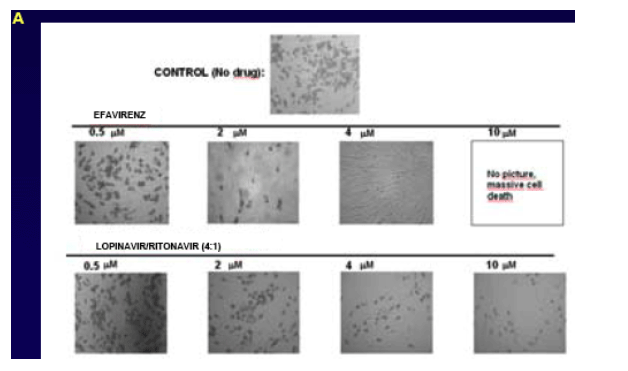
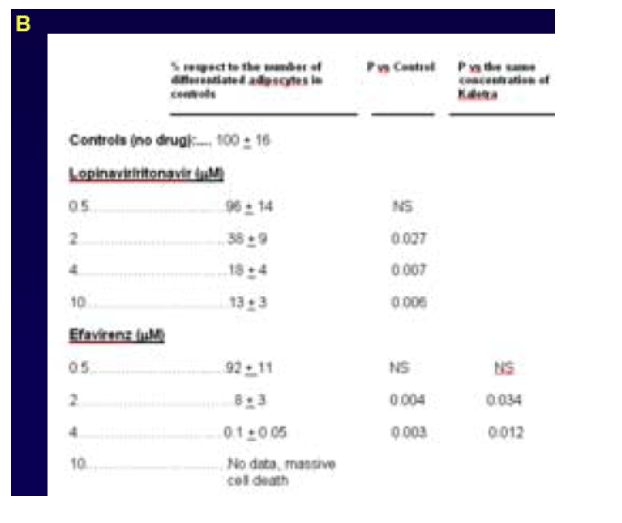
Levels of adiponectin, MCP-1 and lactate released to the culture medium by human adipocytes treated with efavirenz or lopinavir/ritonavir throughout differentiation
Human pre-adipocytes were differentiated in culture in the presence of the indicated concentrations of drugs (10 days since confluence). 25 μl of serum-free culture medium (unchanged during the last 5 days before cell harvest) were used for quantification. Milliplex technology (Millipore) with the corresponding specific antibodies and standard curves were used for adiponectin and MCP-1 release. Lactate was measured using standarized technology from Roche Inc. Data are shown as means ± SEM from 4 independent experiments and are expressed as relative to values from untreated control cells which was set to 1 (dotted line, mean; shaded area, ± SEM). Range levels of specific protein contents in medium in controlswere: adiponectin, 0.24 μg/ml; MCP-1, 3.0 ng/ml.
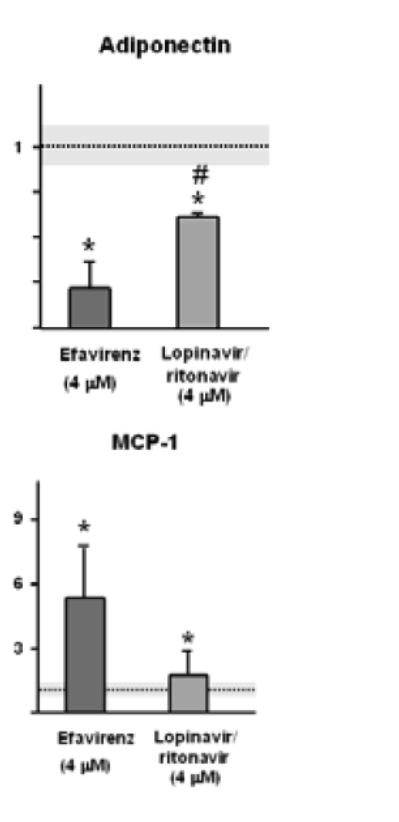
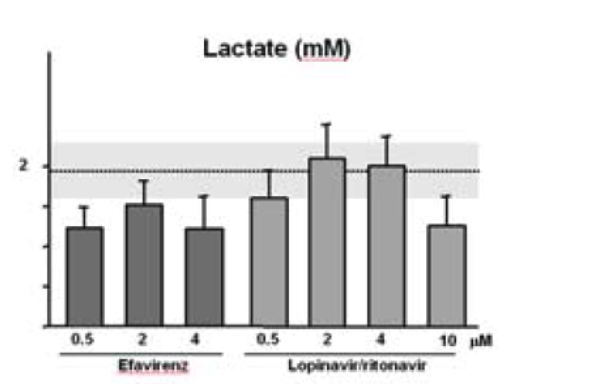
Mitochondrial DNA levels and mRNA expression of marker genes of mitochondriogenesis and adipogenesis in human adipocytes treated with efavirenz or lopinavir/ritonavir throughout differentiation
MITOCHONDRIOGENESIS
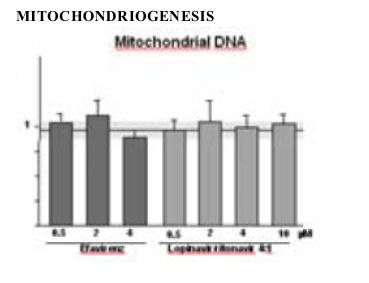
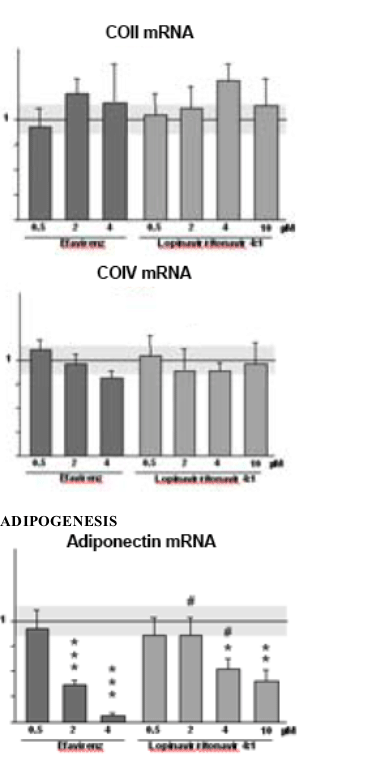
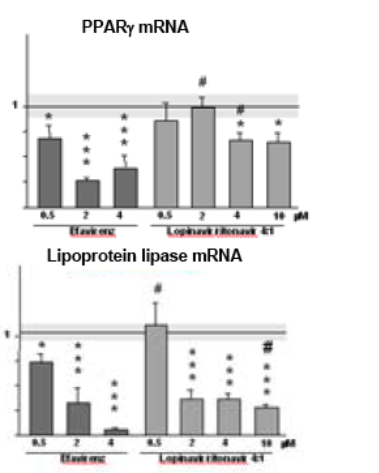
ADIPOGENESIS
Human pre-adipocytes were differentiated in culture in the presence of the indicated concentrations of drugs (10 days since confluence). DNA and RNA were obtained. Mitochondrial DNA and specific transcripts were measured by quantitative real-time PCR using TaqMan technology and the corresponding TaqMan Assay-on-Demand probes (Applied Biosystems), previous retranscription with random primers in the transcript quantification . Data of mitochondrial DNA was referred to nuclear DNA (C/EBPa single-copy gene). Data of transcripts was referred to 18S rRNA and main changes were re-checked using cyclophilin mRNA as alteranative housekeeping transcript. Data are shown as means ± SEM from 3 independent experiments and are expressed as relative to values from untreated control cells which was set to 1 (dotted line, mean; shaded area, ± SEM). Statistical significance of differences respect to controls are shown as * P<0.05, **P<0.01, ***P< 0.001. Those in the comparison of Efavirenz versus Lopnivair/ritonavir at the same concentration of treatment of cells are shown as #.
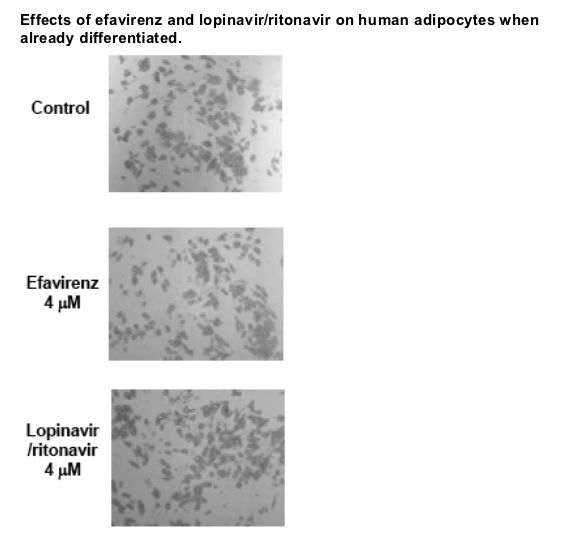
Micrographs of cultures of differentiated human adipocytes (10 days after confluence) treated with the indicated concentrations of drugs during 24h, show no alterations in cell morphology
mRNA expression of marker genes of mitochondriogenesis, adipogenesis and endoplasmic reticulum stress in human adipocytes treated with efavirenz or lopinavir/ritonavir when already differentiated
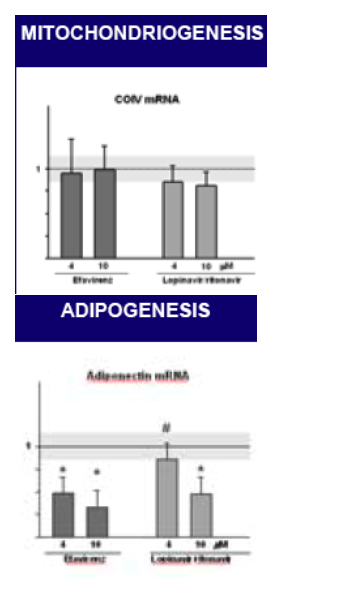
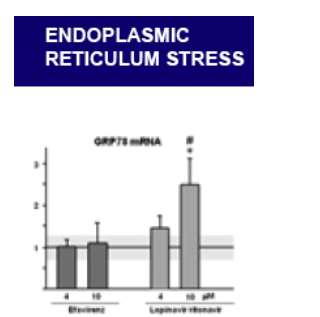
Human pre-adipocytes were differentiated in culture. When already dfiierentiated (10 days after confluence), the cultures were treated with the indicated concentrations of drugs during 24h. RNA was obtained and specific transcripts were measured by quantitative real-time PCR using TaqMan technology and the corresponding TaqMan Assay-on-Demand probes (Applied Biosystems), previous retranscription with random primers. Data of transcripts was referred to 18S rRNA and main changes were re-checked using cyclophilin mRNA as alternative housekeeping transcript. Data are shown as means ± SEM from 3 independent experiments and are expressed as relative to values from untreated control cells which was set to 1 (dotted line, mean; shaded area, ± SEM). Statistical significance of differences respect to controls are shown as * P<0.05, **P<0.01, ***P< 0.001. Those in the comparison of Efavirenz versus Lopnivair/ritonavir at the same concentration of treatment of cells are shown as #.
|
| |
|
 |
 |
|
|